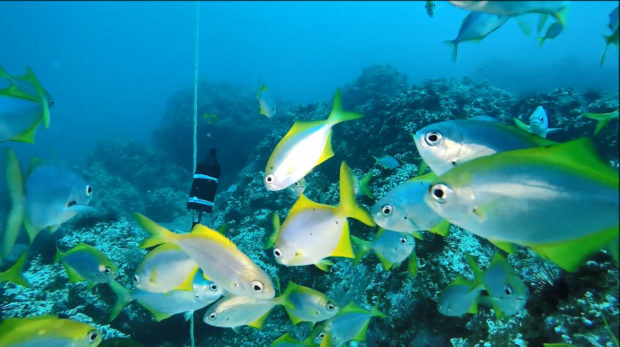
The hydrophone that records the sounds of the ocean for 24 hours is surrounded by an abundant school of Scorpis chilensis, a species endemic to the Juan Fernández Archipelago. Image: Iván Hinojosa
By Paula Díaz Levi
When Ivan Hinojosa was working on his doctorate in Australia, he studied how the reef’s sound oriented lobster larvae, which swam several kilometers from the open ocean to the coastal waters to find a place to settle. These sounds are generated by the interactions of different species, just as happens on land, and constitute guiding signals for these little organisms.
That research about the Australian lobster demonstrated the essential role of underwater sound and inspired an innovative project, this time in the Pacific Ocean along the Chilean coast at the Juan Fernández Archipelago, Easter Island and Quiriquina Island.
“The sound serves as an orientation signal that allows different species of fish and invertebrates to find a place to settle. This is what we are investigating because, although there are some examples in the Great Barrier Reef of Australia and in the United States, we have almost no information about this in our country,” explains Hinojosa, a professor at the Catholic University of the Holy Conception and a scientist at the Ecology and Sustainable Management of Oceanic Islands (ESMOI).
For recording underwater sounds, the researchers use a hydrophone, an instrument that registers the acoustic landscape of the environment or species’ vocalizations for 24 hours.
Although bioacoustics – the science that studies the relationship between living beings and sound – is known for investigating the communication of marine mammals such as whales and dolphins, little is known about smaller organisms such as fish and invertebrates such as crustaceans and mollusks.
“The fish vocalize to attract the female, as the birds do in a forest. During the afternoon and evening, you can hear a fish chorus that vocalizes, very similar to the birds when they start singing at dawn and dusk. We have a similar situation underwater, but we don’t know so much about the ecological relevance of this,” Hinojosa says.
The director of ESMOI, Carlos Gaymer, adds: “This research line is relatively new. It is tremendously interesting to understand what is the role of sound in the species populations that are part of the ecosystems. Not all of them would act exactly in the same way, and not because certain things happen in other places will be the same here.”
Shrimp and noisy humans
“When you install the hydrophone, the first thing you will hear near the reef or the coast are clicks, just like the clicks you do with your fingers. That noise is issued by snapping shrimp, which are everywhere. They are the noisiest,” says Hinojosa.
However, the recordings reveal interesting differences among the three studied islands. The amount of fish that vocalize at Juan Fernández is considerably higher than anywhere else. In addition, they’ve detected more diversity of sounds compared with other places, he says
Juan Fernández is known for its high level of endemic species that live only in that corner of the planet. In addition, it has protected marine areas and small-scale human activities. For those reasons, the populations of its marine fauna are currently healthy.
On the other hand, vocalizations of some fish, such as the surgeonfish (maïto in the Rapa Nui language), have been identified at Easter Island. After an intense day of work, the hydrophone even recorded the unexpected song of humpback whales that passed nearby, Hinojosa says.
Finally, vocalizations of fish are scarce at Quiriquina Island, located near the coast of Talcahuano city. The sounds produced there by invertebrates such as snapping shrimp predominate.
The final goal of the research is to assess the impact of human noise in the Chilean ocean.
It is known that noise pollution can affect the physiology and behavior of marine species, threatening even their survival, one of the reasons that make it necessary to investigate in depth, according to both scientists.”Human sounds, such as those produced by port activity or navigation, can mask the natural sounds required by species. If human noise ‘plugs’ the natural sounds, it can generate an impact on the settlement and incorporation of the larvae to the populations of their own species, causing consequences in the ecosystems, as well as in other aspects such as the decrease of resources available in fishing areas,” Gaymer says.
Paula Díaz Levi is a Chilean journalist and a participant in a recent Knight Center for Environmental Journalism workshop.

I do not know whether it’s just me or if perhaps everybody else
experiencing issues with your website. It looks like some of
the text in your content are running off the screen. Can someone else please comment and let me know if
this is happening to them too? This might be a issue with
my browser because I’ve had this happen before. Many thanks